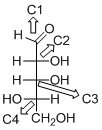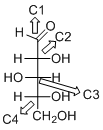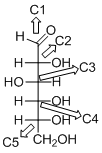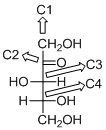
(a)
Interpretation:
The given molecule is D or L should be identified.
Concept introduction:
Monosaccharides: (single sugar unit) simple sugars units are the most basic units of carbohydrates.
Structure and nomenclature: Monosaccharide has this chemical formula:
Monosaccharides can be classified by the number x of carbon atoms. If they contain three carbon atom and is called triose. If they contain four carbon and is called tetrose, if they contain five carbon and is called pentose, if they contain six carbon and is called hexose and so on.
Aldose: A monosaccharide in which carbon serves as a backbone and contains an
Ketose: A ketose is a simple sugar unit (monosaccharide) containing one
D and L enantiomers: L isomers have the hydroxyl group attached to the left side of the asymmetric carbon furthest from the carbonyl.
R isomers have the hydroxyl group attached to the right side of the asymmetric carbon furthest from the carbonyl.
To find: Type of enantiomers.
(a)
Answer to Problem 42PP
Answer
The given compound is D-aldotetrose (a).

Explanation of Solution
The OH group connected to C3 is pointing to the right side, so it is called as D-sugar. The
(b)
Interpretation:
The given molecule is D or L should be identified.
Concept introduction:
Monosaccharides: (single sugar unit) simple sugars units are the most basic units of carbohydrates.
Structure and nomenclature: Monosaccharide has this chemical formula:
Monosaccharides can be classified by the number x of carbon atoms. If they contain three carbon atom and is called triose. If they contain four carbon and is called tetrose, if they contain five carbon and is called pentose, if they contain six carbon and is called hexose and so on.
Aldose: A monosaccharide in which carbon serves as a backbone and contains an aldehyde group at the beginning.
Ketose: A ketose is a simple sugar unit (monosaccharide) containing one ketone group per molecule.
D and L enantiomers: L isomers have the hydroxyl group attached to the left side of the asymmetric carbon furthest from the carbonyl.
R isomers have the hydroxyl group attached to the right side of the asymmetric carbon furthest from the carbonyl.
To find: Type of enantiomers.
(b)
Answer to Problem 42PP
Answer
The given compound is L-aldopentose (b).

Explanation of Solution
The given compound is L-aldopentose.

The OH group connected to C4 is pointing to the left side, so it is called as L-sugar. The functional group at Cl is an aldehyde group, so the compound is an aldose. Finally, the compound has five carbon atoms, so it is a pentose. The given compound is an L-aldopentose
(c)
Interpretation:
The given molecule is D or L should be identified.
Concept introduction:
Monosaccharides: (single sugar unit) simple sugars units are the most basic units of carbohydrates.
Structure and nomenclature: Monosaccharide has this chemical formula:
Monosaccharides can be classified by the number x of carbon atoms. If they contain three carbon atom and is called triose. If they contain four carbon and is called tetrose, if they contain five carbon and is called pentose, if they contain six carbon and is called hexose and so on.
Aldose: A monosaccharide in which carbon serves as a backbone and contains an aldehyde group at the beginning.
Ketose: A ketose is a simple sugar unit (monosaccharide) containing one ketone group per molecule.
D and L enantiomers: L isomers have the hydroxyl group attached to the left side of the asymmetric carbon furthest from the carbonyl.
R isomers have the hydroxyl group attached to the right side of the asymmetric carbon furthest from the carbonyl.
To find: Type of enantiomers.
(c)
Answer to Problem 42PP
Answer
The given compound is D-aldopentose (c).

Explanation of Solution
The given compound is D-aldopentose.

The OH group connected to C4 is pointing to the right side, so this is a D-sugar. The functional group at Cl is an aldehyde group, so the compound is an aldose. Finally, the compound has five carbon atoms, so it is a pentose. The given compound is a D-aldopentose.
(d)
Interpretation:
The given molecule is D or L should be identified.
Concept introduction:
Monosaccharides: (single sugar unit) simple sugars units are the most basic units of carbohydrates.
Structure and nomenclature: Monosaccharide has this chemical formula:
Monosaccharides can be classified by the number x of carbon atoms. If they contain three carbon atom and is called triose. If they contain four carbon and is called tetrose, if they contain five carbon and is called pentose, if they contain six carbon and is called hexose and so on.
Aldose: A monosaccharide in which carbon serves as a backbone and contains an aldehyde group at the beginning.
Ketose: A ketose is a simple sugar unit (monosaccharide) containing one ketone group per molecule.
D and L enantiomers: L isomers have the hydroxyl group attached to the left side of the asymmetric carbon furthest from the carbonyl.
R isomers have the hydroxyl group attached to the right side of the asymmetric carbon furthest from the carbonyl.
To find: Type of enantiomers.
(d)
Answer to Problem 42PP
Answer
The given compound is D-aldohexose (d).

Explanation of Solution
The given compound is D-aldohexose.

The OH group connected to C5 is pointing to the right side, so this is a D-sugar. The functional group at Cl is an aldehyde group, so the compound is an aldose. Finally, the compound has six carbon atoms, so it is called as a hexose. The given compound is a D-aldohexose
(e)
Interpretation:
The given molecule is D or L should be identified.
Concept introduction:
Monosaccharides: (single sugar unit) simple sugars units are the most basic units of carbohydrates.
Structure and nomenclature: Monosaccharide has this chemical formula:
Monosaccharides can be classified by the number x of carbon atoms. If they contain three carbon atom and is called triose. If they contain four carbon and is called tetrose, if they contain five carbon and is called pentose, if they contain six carbon and is called hexose and so on.
Aldose: A monosaccharide in which carbon serves as a backbone and contains an aldehyde group at the beginning.
Ketose: A ketose is a simple sugar unit (monosaccharide) containing one ketone group per molecule.
D and L enantiomers: L isomers have the hydroxyl group attached to the left side of the asymmetric carbon furthest from the carbonyl.
R isomers have the hydroxyl group attached to the right side of the asymmetric carbon furthest from the carbonyl.
To find: Type of enantiomers.
(e)
Answer to Problem 42PP
Answer
The given compound is D-ketopentose (e).

Explanation of Solution
The given compound is D-ketopentose.

The OH group connected to C4 is pointing to the right side, so this is a D-sugar. The functional group at C2 is a ketone group, so the compound is a ketose. Finally, the compound has five carbon atoms, so it is a pentose. The given compound is a D-ketopentose.
Want to see more full solutions like this?
Chapter 24 Solutions
ORGANIC CHEMISTRY-STD.WILEY PLUS CARD
- For each reaction below, decide if the first stable organic product that forms in solution will create a new CC bond, and check the appropriate box. Next, for each reaction to which you answered "Yes" to in the table, draw this product in the drawing area below. Note for advanced students: for this problem, don't worry if you think this product will continue to react under the current conditions - just focus on the first stable product you expect to form in solution. དྲ。 ✗MgBr ? O CI Will the first product that forms in this reaction create a new C-C bond? Yes No • ? Will the first product that forms in this reaction create a new CC bond? Yes No × : ☐ Xarrow_forwardPredict the major products of this organic reaction: OH NaBH4 H ? CH3OH Note: be sure you use dash and wedge bonds when necessary, for example to distinguish between major products with different stereochemistry. Click and drag to start drawing a structure. ☐ : Sarrow_forwardPredict the major products of this organic reaction: 1. LIAIHA 2. H₂O ? Note: be sure you use dash and wedge bonds when necessary, for example to distinguish between major products with different stereochemistry. Click and drag to start drawing a structure. X : ☐arrow_forward
- For each reaction below, decide if the first stable organic product that forms in solution will create a new C - C bond, and check the appropriate box. Next, for each reaction to which you answered "Yes" to in the table, draw this product in the drawing area below. Note for advanced students: for this problem, don't worry if you think this product will continue to react under the current conditions - just focus on the first stable product you expect to form in solution. NH2 tu ? ? OH Will the first product that forms in this reaction create a new CC bond? Yes No Will the first product that forms in this reaction create a new CC bond? Yes No C $ ©arrow_forwardAs the lead product manager at OrganometALEKS Industries, you are trying to decide if the following reaction will make a molecule with a new C-C bond as its major product: 1. MgCl ? 2. H₂O* If this reaction will work, draw the major organic product or products you would expect in the drawing area below. If there's more than one major product, you can draw them in any arrangement you like. Be sure you use wedge and dash bonds if necessary, for example to distinguish between major products with different stereochemistry. If the major products of this reaction won't have a new CC bond, just check the box under the drawing area and leave it blank. Click and drag to start drawing a structure. This reaction will not make a product with a new CC bond. G marrow_forwardIncluding activity coefficients, find [Hg22+] in saturated Hg2Br2 in 0.00100 M NH4 Ksp Hg2Br2 = 5.6×10-23.arrow_forward
- give example for the following(by equation) a. Converting a water insoluble compound to a soluble one. b. Diazotization reaction form diazonium salt c. coupling reaction of a diazonium salt d. indacator properties of MO e. Diazotization ( diazonium salt of bromobenzene)arrow_forward2-Propanone and ethyllithium are mixed and subsequently acid hydrolyzed. Draw and name the structures of the products.arrow_forward(Methanesulfinyl)methane is reacted with NaH, and then with acetophenone. Draw and name the structures of the products.arrow_forward
- 3-Oxo-butanenitrile and (E)-2-butenal are mixed with sodium ethoxide in ethanol. Draw and name the structures of the products.arrow_forwardWhat is the reason of the following(use equations if possible) a.) In MO preperation through diazotization: Addition of sodium nitrite in acidfied solution in order to form diazonium salt b.) in MO experiment: addition of sodium hydroxide solution in the last step to isolate the product MO. What is the color of MO at low pH c.) In MO experiment: addition of sodium hydroxide solution in the last step to isolate the product MO. What is the color of MO at pH 4.5 d.) Avoiding not cooling down the reaction mixture when preparing the diazonium salt e.) Cbvcarrow_forwardA 0.552-g sample of an unknown acid was dissolved in water to a total volume of 20.0 mL. This sample was titrated with 0.1103 M KOH. The equivalence point occurred at 29.42 mL base added. The pH of the solution at 10.0 mL base added was 3.72. Determine the molar mass of the acid. Determine the Ka of the acid.arrow_forward
 ChemistryChemistryISBN:9781305957404Author:Steven S. Zumdahl, Susan A. Zumdahl, Donald J. DeCostePublisher:Cengage Learning
ChemistryChemistryISBN:9781305957404Author:Steven S. Zumdahl, Susan A. Zumdahl, Donald J. DeCostePublisher:Cengage Learning ChemistryChemistryISBN:9781259911156Author:Raymond Chang Dr., Jason Overby ProfessorPublisher:McGraw-Hill Education
ChemistryChemistryISBN:9781259911156Author:Raymond Chang Dr., Jason Overby ProfessorPublisher:McGraw-Hill Education Principles of Instrumental AnalysisChemistryISBN:9781305577213Author:Douglas A. Skoog, F. James Holler, Stanley R. CrouchPublisher:Cengage Learning
Principles of Instrumental AnalysisChemistryISBN:9781305577213Author:Douglas A. Skoog, F. James Holler, Stanley R. CrouchPublisher:Cengage Learning Organic ChemistryChemistryISBN:9780078021558Author:Janice Gorzynski Smith Dr.Publisher:McGraw-Hill Education
Organic ChemistryChemistryISBN:9780078021558Author:Janice Gorzynski Smith Dr.Publisher:McGraw-Hill Education Chemistry: Principles and ReactionsChemistryISBN:9781305079373Author:William L. Masterton, Cecile N. HurleyPublisher:Cengage Learning
Chemistry: Principles and ReactionsChemistryISBN:9781305079373Author:William L. Masterton, Cecile N. HurleyPublisher:Cengage Learning Elementary Principles of Chemical Processes, Bind...ChemistryISBN:9781118431221Author:Richard M. Felder, Ronald W. Rousseau, Lisa G. BullardPublisher:WILEY
Elementary Principles of Chemical Processes, Bind...ChemistryISBN:9781118431221Author:Richard M. Felder, Ronald W. Rousseau, Lisa G. BullardPublisher:WILEY





